14 Animal Diversity
Download this lab as a Microsoft Word document.
Download the lab response form (Microsoft Word document) to access the questions only.
Purpose
To investigate the diversity of animals and their closest protist relatives.
Learning Objectives
At the conclusion of this exercise, students will be able to:
- Identify some common animal and protist groups.
- Describe the major evolutionary innovations in the Kingdom Animalia.
- Infer the relatedness of animal species based on shared characteristics.
Why It’s Relevant
There are millions of species of animals on Earth, and they all play vital roles in their respective ecosystems. Further, humans are a type of animal, so understanding their anatomy and physiology is of direct relevance to the field of medicine. Learning about the variety and evolutionary history of animals helps us make sense of our place in existence.
Introduction
Animals are multicellular eukaryotes that are abundant in both aquatic and terrestrial habitats. The critical difference between animals and plants is that animals are heterotrophic and not capable of photosynthesis. As such, they must find, capture, and ingest their food in order to gain energy.
Animals evolved from simpler, unicellular eukaryotes called protists. Some of these, the “animal-like protists,” also ingest their food and share many genes in common with animals. Modern versions of these are the closest living relatives to animals. Note that animal-like protists are more closely related to animals than they are to other protists (Figure 14.1).
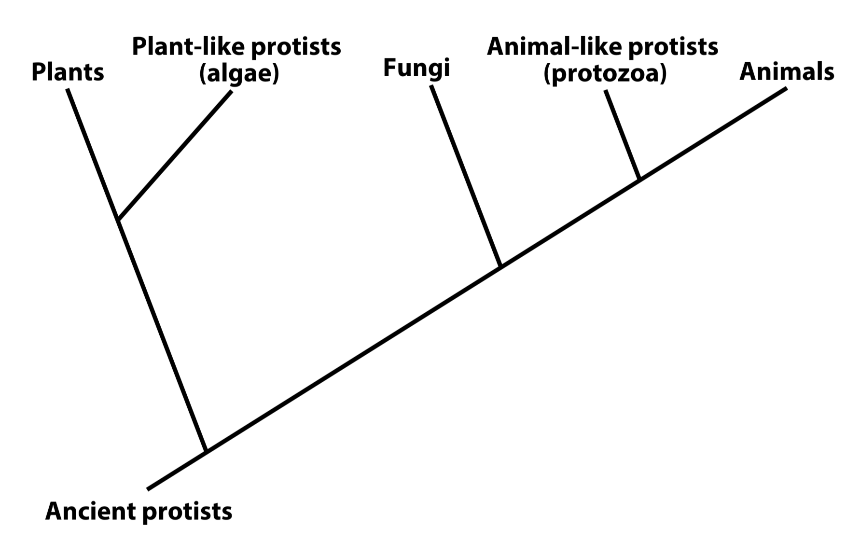
The animal kingdom exhibits incredible diversity, with over 1.5 million species described by scientists. The vast majority of these are invertebrates (animals with no backbone), which exhibit a wide variety of body forms. A minority are vertebrates and are descended from ancestors that evolved the backbone that your body exhibits today (Figure 14.2).

Animals play many important roles in ecosystems as consumers and detritivores. Their diversity and evolutionary history have long captivated the human mind—think of all the different animals you can name. It’s probably quite a varied group! In addition, animals play important roles in human society as pets, livestock, pests, disease vectors, and as medical research specimens. Even though it might not immediately seem that way, the way your body develops and functions is not dramatically different from that of a mouse, a frog, or an insect! Clearly the field of zoology is an important one that continues to provide valuable information to human society.
In this lab, you will study a variety of model organisms, from simple animal-like protists to highly complex vertebrate animals. Model organisms are very well-studied representatives of particular groups that provide insight into how all members of that group function. As you proceed, you will learn about some of the important traits that have evolved in animals over time that led to new and often more complex body forms.
Procedure
You will begin by observing some unicellular animal-like protists that are closely related to animals. Both of these organisms share many genes with animals and ingest food like animals do.
Make a wet mount of the Paramecium specimen by adding a drop of the solution containing them from the lab supply. Before you put a coverslip on, add a drop of methyl cellulose. This is a viscous chemical that slows the Paramecium down enough that you can view them under high magnification. Search for the moving protists at scanning power (40X total magnification), then magnify them at low power (100X total magnification) or at high power (400X total magnification, if possible). Note that Paramecium is a kind of ciliate, meaning that it possesses many short cilia along its outer cell membrane that allow for smooth movement through its substrate. You may be able to view a constantly beating contractile vacuole that is working to remove extra water that leaks into the cell. Make a sketch of a Paramecium and label the contractile vacuole.
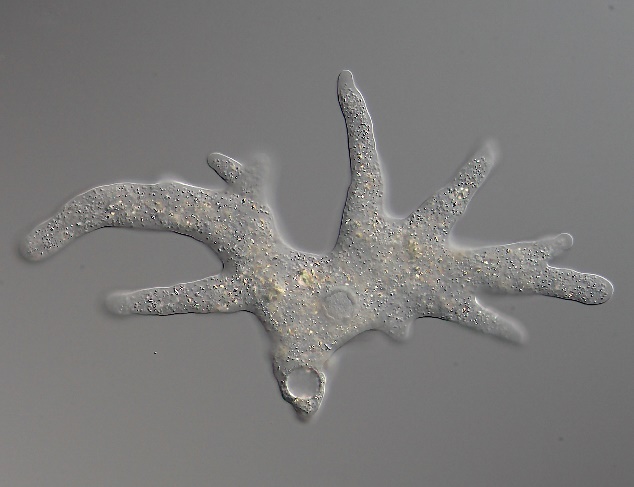
Make a wet mount of the Amoeba specimen. Amoebas are not nearly as fast-moving as other protists, so you won’t need to add methyl cellulose this time. Look for the transparent, single-celled organisms at scanning power and then magnify to higher power when you locate one. Amoebas move by constantly changing shape (Figure 14.3). You should be able to observe this action. Cytoplasm in the cell will stream into an “arm” of the amoeba, which elongates and expands in size, eventually dragging the rest of the organism with it. This extension is called a pseudopodium (“false foot”), and amoebas use it to crawl along their substrates. Make a sketch of one Amoeba and label a pseudopodium.
Next, you begin exploring the animal kingdom by looking at some common
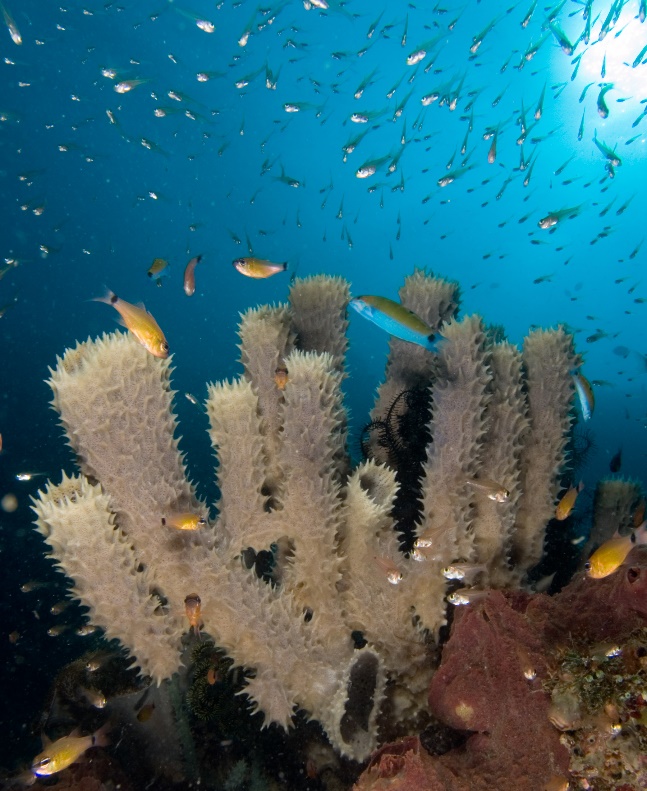
representative organisms. All animals are multicellular, unlike their protist relatives. Most animals exhibit bilateral symmetry, meaning that they have a relatively complex body that has distinct top and bottom sides, as well as distinct front and back ends. Simpler forms do not. Observe the sponge and jelly specimens on display in the lab for examples of simpler animals.
Sponges are the simplest of all animals. They consist of unconnected cells that secrete a protein skeleton around themselves (Figure 14.4). You are looking at this protein skeleton now. When alive, it was populated with thousands of microscopic sponges lining tiny channels throughout the skeleton. Ocean water was pulled through these channels by the cells, which ingested any tiny food particles in the water. Make a sketch of a sponge skeleton.
Jellies exhibit a more complex body than sponges, but they are still relatively simple. Note the lack of a head on this animal that appears the same all the way around its body. As you probably know, jellies possess many stinging cells on their tentacles, which they use to subdue their prey. Food items are pulled into the mouth, which is directly underneath the bell at the top. Since the animal does not have a front or back end, however, this mouth must also serve as an anus! Undigested food is ejected from the same opening that is used to enter the digestive cavity. Make a sketch of a jelly and label the tentacles.
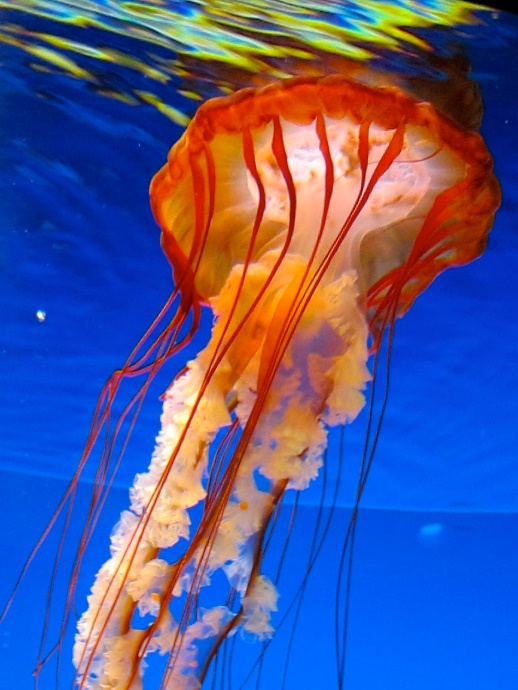
You are ready now to consider more complex invertebrate organisms. The ancestors of this group evolved bilateral symmetry and transformed into animals with distinct back and front ends. The front has often developed into a complicated “head” region, with many sensory and feeding structures. In addition to bilateral symmetry, this group evolved the ability to produce additional tissues which convey the potential to produce complex body organs and structures like muscle, cartilage, and blood. Complex invertebrates are classified into 3 major evolutionary categories: those that shed an external skeleton, those that grow continuously throughout their lifetime, and those that re-evolved radial symmetry (Figure 14.2).
Observe the arthropods (insects, crustaceans, and spiders) and roundworms that are on display in the lab. All of these are invertebrates that produce a non-living exoskeleton that must be shed in order to grow (Figure 14.6). This outer layer is thick in arthropods and much thinner in roundworms, but shedding is required for both. Imagine how vulnerable these animals feel when they crawl out of their skeletons, grow as fast as they can, and then begin to secrete a new exoskeleton! Make a sketch of any two of the invertebrates in this category.
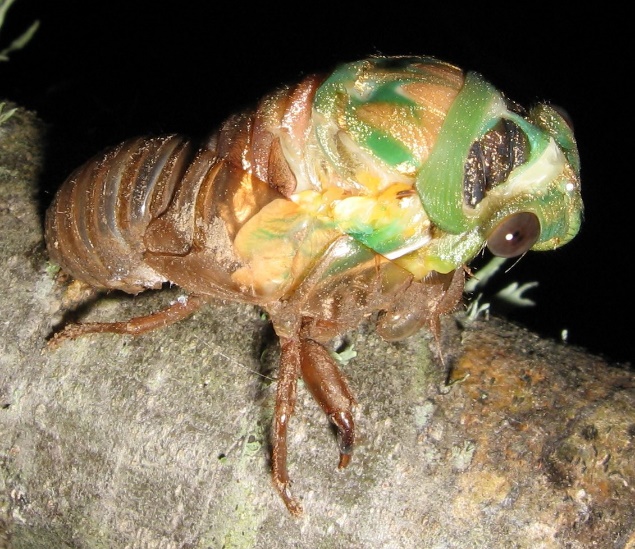
Next, observe the mollusks (snails, clams, and octopus), earthworms, and flatworms on display in the lab. All of these are invertebrates with bilateral symmetry as well, but they do not produce an exoskeleton which must be shed (Figure 14.7). Some of the mollusks are capable of producing shells, but shells can be remodeled as an organism grows and do not need to be shed. Make a sketch of any two of the invertebrates in this category.
Finally, observe the sea stars and sea urchins on display in the lab. These
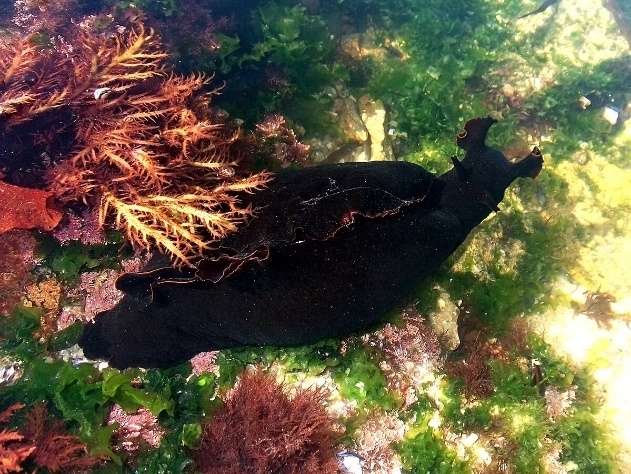
animals belong to an interesting group of invertebrates that lost their bilateral symmetry over time and reverted back to a simpler body plan (evolution does not always lead to greater complexity!) (Figure 14.8). Their larval forms actually exhibit distinct front and back ends, but as these species turn into adults, they transform into animals that appear the same all the way around their bodies. It may be tempting to think of them as very simple animals like jellies, but this is not true. Their bodies contain complicated organ systems, and they share more of their DNA in common with you than with jellies! Make a sketch of one of the organisms in this group.
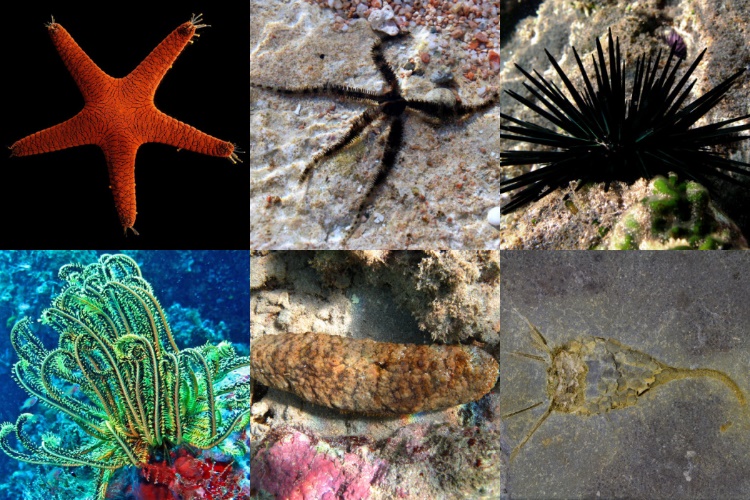
The remaining animals on display are all vertebrates and are more closely related to each other than to the other groups of animals (Figure 14.9). Vertebrates (Figure 14.10) possess a backbone that runs down the back (top) side of their bilaterally symmetrical body. Muscles and nerves attach to this skeletal element and extend to different parts of the body. The backbone encloses and protects the spinal cord, a massive and hollow nerve that is continuous with the well-developed brain in the animal’s head.


Sharks and rays belong to a group of vertebrates known as cartilaginous fish. They possess many of the same skeletal elements that you do, but they are made of cartilage rather than bone. This tissue is more or less similar to the cartilage that forms the tips of our noses and our ears! This is the main reason why complete shark fossils are so rare! Make a sketch of a shark and label the dorsal, pelvic, and pectoral fins.
Bony fish are some of the most abundant vertebrates on Earth, with over 20,000 described species. They breathe ocean or fresh water using gills and swim using fins, like sharks do. Unlike sharks, however, their fins are supported by rays made of bone, and the rest of their skeleton is bony as well. Make a sketch of a bony fish and label the dorsal, pelvic, and pectoral fins.
One of the most interesting evolutionary events involved the transition of ancient bony fish into land-dwelling vertebrates. These early creatures traded their gills for lungs, and their bony fins transformed into bony limbs over millions of years. Some of the descendants of these ancestors became today’s modern amphibians. Amphibians, such as frogs and salamanders, live on land but remain closely tied to water. Many species exhibit aquatic larvae (“tadpoles”), and the adults are covered by a thin skin that must stay moist in order for them to breathe. Their young typically hatch out of very thin eggs that must be laid in a pond because they are so susceptible to dehydration. Make a sketch of a larval and an adult frog and label the gills on the larval form.
One lineage of land-dwelling vertebrates became the amphibians, while another further adapted to the dry conditions on land and became ancient reptiles. Modern reptiles are descended from these. They possess a much thicker skin than amphibians have, and their skin is covered with scales or feathers. There are no tadpole larvae in this group, and the young are born live or hatch from amniotic eggs that possess waterproof shells. Make a sketch of any two of the reptiles on display in the lab.
One offshoot branch of the ancient reptiles progressed along a unique evolutionary pathway. This group developed hair and the ability to produce milk with which to feed their young—they became modern mammals. Modern mammals are adapted for dry conditions as reptiles are. Their hair limits evaporation from the skin and their young are born live or, in the case of the duck-billed platypus for example, from amniotic eggs! Make a sketch of any mammal specimen on display in the lab.
Alternate Procedure for Online Courses
Georgia Aquarium is a zoological park located in downtown Atlanta, GA. When it opened in 2005 it was the largest public aquarium in the world and continues to be one of the biggest both in terms of square footage and annual visitors. It is one of the few aquaria in the world big enough to house whale sharks, the largest living species of shark on Earth!
As an exercise today, you will take a virtual tour of Georgia Aquarium to learn about some of the animals it exhibits and to relate them to course concepts. Navigate to the aquarium’s website to begin your exploration. Once there, click on the “animals and exhibits” tab near the top of the page. Select “all animals” to enter a database in which you can search through all of the different animal species featured at Georgia Aquarium. The most useful option in the database is the “filter by type” tool located at the top of the page, which will help you sort animals into their respective biological classification categories.
First, you will create a list of animals at Georgia Aquarium that captivate you, inspire you, or otherwise draw your interest that you are willing to study in more detail. Select at least one species from each of the ten major categories of animals described in the Introduction section of this lab (see Table 14.1 below). Since sponges are not currently represented at Georgia Aquarium, this will lead to a list of nine organisms. Choose any other three species that interest you to make a total of 12 animal species.
|
Major Animal Group |
Common Representative Organisms |
|---|---|
|
Invertebrates (>95% of all known animal species) |
|
|
Sponges |
sponges |
|
Simple animals with radial symmetry |
jellyfish, anemones, corals |
|
Arthropods |
insects, spiders, crustaceans (crabs, lobster, etc.) |
|
Mollusks |
snails, clams, squid, octopus |
|
Animals with bilateral symmetry as larvae and radial symmetry as adults |
sea stars, sea urchins, sand dollars |
|
Vertebrates (<5% of all known animal species) |
|
|
Cartilaginous fish |
sharks, rays |
|
Bony fish |
many freshwater and saltwater forms of “fish,” eels, seahorses |
|
Amphibians |
frogs, salamanders |
|
Reptiles |
snakes, turtles, lizards, birds |
|
Mammals |
any animal with fur, including whales, dolphins, otters |
Next, you will create a document (e.g., PowerPoint, .pdf document, etc.) that compares the 12 animal species that you have chosen to investigate. Your final document should include:
- A title page/slide
- A table of contents
- A table you have created that compares your chosen animals across a set of columns with important traits described in this lab. The table should have 13 rows (one for each of your chosen organisms and a header row) and should contain separate columns for the major animal group (see Table 14.1), the animal’s scientific name (properly formatted), whether or not the animal is a vertebrate, whether or not the animal possesses bones, whether or not the animal possesses limbs (not fins), whether the animal is adapted for dry conditions with scales or hair, and finally, whether the animal produces milk to feed its young. A sample table entry for one organism can be viewed in Table 14.2.
- A separate page for each of your 12 chosen animals in which you display information you have learned by researching each species. These pages should include the animal’s common and scientific names, at least two images of the animal (try to choose images from different life stages, such as young vs. adult, or different biological sexes), the country/region in which the animal is found, what the animal typically feeds on, a description of the habitat in which the animal lives, and two adaptations your animal possesses that helps it survive in its particular habitat.. You will find some of this information on the Georgia Aquarium website but will need to use additional print/internet sources as well. Make sure to list the reference for any piece of information not taken from the Georgia Aquarium site.
|
Animal Species |
Major Animal Group |
Scientific Name |
Vertebrate (Y or N) |
Bones (Y or N) |
Limbs (Y or N) |
Possess Scales/Hair (Y or N) |
Produce Milk (Y or N) |
|---|---|---|---|---|---|---|---|
|
African Pancake Tortoise |
Reptile |
Malacochersus tornieri |
Y |
Y |
Y |
Y |
N |
Your instructor will indicate how to submit the document described above. Read through this lab carefully and answer the summary questions below.
Summary Questions
- Give a major way in which animal-like protists are similar to animals and a major way in which they differ.
- Explain what is meant by bilateral symmetry. Give an example of a type of animal that exhibits it and one that does not.
- List the 3 major types of complex invertebrates and give an example of an animal that fits into each group.
- Imagine that a new species is discovered in the Amazon rainforest. This animal exhibits bilateral symmetry and produces a backbone. It has limbs that help it move along the rainforest floor, but it lays thin, fish-like eggs in streams when it reproduces. Based on your observations today, which major group of animals should this new species be classified into?
- According to Figure 14.9, are goldfish more closely related to sharks or to dogs? Give at least one trait shared by goldfish and its closer relative to support the relatedness displayed in the figure.
- As explained in this lab, arthropods are covered with a thick exoskeleton. What is a major advantage and a major disadvantage of having an exoskeleton?
- What are two major traits possessed by lizards that make them better adapted for life in dry environments than salamanders are?

